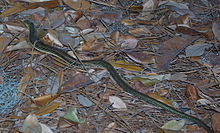| Ophisaurus Temporal range:
| |
|---|---|

| |
| Eastern glass lizard (Ophisaurus ventralis) | |
| Scientific classification | |
| Domain: | Eukaryota |
| Kingdom: | Animalia |
| Phylum: | Chordata |
| Class: | Reptilia |
| Order: | Squamata |
| Family: | Anguidae |
| Subfamily: | Anguinae |
| Genus: | Ophisaurus Daudin, 1803[1] |
| Type species | |
| Anguis ventralis Linnaeus, 1766
| |
| Species | |
|
See text | |

Ophisaurus (from the Greek 'snake-lizard') is a genus of superficially snake-like legless lizards in the subfamily Anguinae. Known as joint snakes, glass snakes, or glass lizards, they are so-named because their tails are easily broken; like many lizards, they have the ability to deter predation by dropping off part of the tail, which can break into several pieces, like glass. The tail remains mobile, distracting the predator, while the lizard becomes motionless, allowing eventual escape. This serious loss of body mass requires a considerable effort to replace, and can take years to do so. Despite this ability, the new tail is usually smaller than the original.
Although most species have no legs, their head shapes, movable eyelids, and external ear openings identify them as lizards. A few species have very small, stub-like legs near their rear vents. These are vestigial organs, meaning they once served an evolved purpose but are no longer used. They reach lengths of up to 1.2 metres (4 ft), but about two-thirds of this is the tail. Glass lizards feed on insects, spiders, other small reptiles, and young rodents. Their diets are limited by their inability to unhinge their jaws. Some glass lizards give birth to live young but most lay eggs.
- ^ "Ophisaurus". Integrated Taxonomic Information System. www.itis.gov.